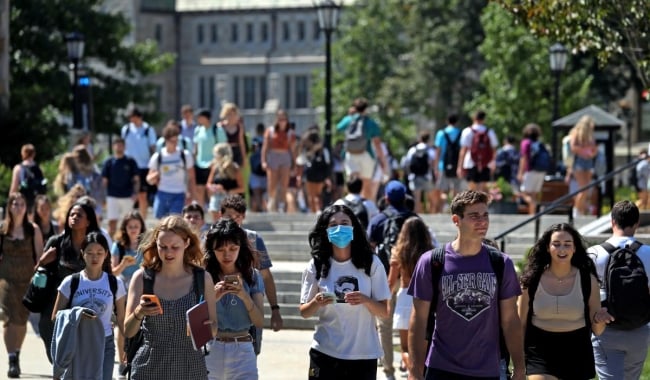You have /5 articles left.
Sign up for a free account or log in.

Students returned to Boston College in August. On many campuses, COVID cases are back, too—but not mask mandates or quarantine housing.
David L. Ryan/The Boston Globe/Getty Images
The start of the fall semester has brought more than students back to college campuses. As dorms and lecture halls fill up again, COVID-19 cases are spiking at some institutions.
Ever since the pandemic started in March of 2020, campus COVID cases have surged with the return of students at the beginning of each new semester, only to level off a few weeks later. Still, some of this fall’s numbers have been alarmingly high, raising concerns that safety protocols and guidelines were relaxed too early.
The University of Illinois at Urbana-Champaign has seen more cases in the past few weeks than at any time since the start of the pandemic. On Aug. 30 the university reported 326 new cases, its highest ever single-day count; the next highest was on Feb. 1, 2022, when 287 cases of the virus were reported. During the first week of classes, which started Aug. 22, the university reported over 1,000 new cases of the virus—a positivity rate of 21 percent.
Mike DeLorenzo, Urbana-Champaign’s vice chancellor for administration and operations, wrote in an email to Inside Higher Ed that this semester’s positivity rate should not be compared to earlier rates, since the majority of students using the university’s testing infrastructure are either part of the 6 percent of the student body that is unvaccinated—and thus required to submit to testing—or are exhibiting symptoms.
Urbana-Champaign has issued a “strong recommendation” for indoor masking, and DeLorenzo said it is considering additional measures to prevent further spread.
“We are looking at the trend lines, clustering and risks with advice from university COVID-19 experts, and we are taking appropriate actions,” he wrote. “We have confidence in our approach, and we expect our case numbers to return to more expected levels in the next couple of weeks, as they have each semester.”
Anita Barkin, co-chair of the American College Health Association COVID-19 task force, said surges like Urbana-Champaign’s are “not unexpected.” She recommends that colleges maintain some kind of surveillance testing infrastructure and strongly encourage students to wear masks indoors, while coordinating with local health departments to respond to particularly severe outbreaks.
But she doesn’t anticipate, or recommend, a return to the weekly testing regimens and strict masking guidelines that defined college life for much of the past two years.
“Unless we see a variant surface that presents with more serious consequences health-wise for the campus community, I don’t see schools implementing a lot of the strategies that were used earlier on in the pandemic,” Barkin said.
From Public Safety to ‘Personal Responsibility’
It’s been more than two years since the start of the pandemic, and most institutions have reduced their COVID safety measures. Daily PCR testing became less widely available on campuses as vaccination rates rose and do-it-yourself antigen tests grew more common. Some institutions have either discontinued their COVID dashboards or significantly reduced data input for them. Quarantine housing has been drastically scaled back, if not eliminated entirely, on most campuses.
The rise in cases over the past month raises a question: Did campuses do away with these protocols too early?
Some universities have moved back to certain pre-vaccination measures when faced with the prospect of rising infection rates. When the BA.5 subvariant brought a fresh wave of COVID cases to colleges in California this summer, several institutions responded by reinstating indoor mask mandates. In August the University of Delaware put a temporary mask mandate in place ahead of students’ return to campus, anticipating a potential surge.
Pennsylvania State University has reduced quarantine housing options from hundreds of single-occupancy rooms to fewer than 50. Because Penn State paused its COVID dashboard in April, case numbers for the start of this semester are unknown, but there have been enough to overwhelm the university’s remaining isolation housing. As of last week, all 46 isolation rooms were in use, and an additional 28 rooms in a local hotel were housing infected students off campus.
Barkin said she doesn’t anticipate a return to the kinds of costly, logistically complicated measures that dominated campus responses to the pandemic at its height. Instead, she said, universities are looking at longer-term efforts, like improving ventilation in campus buildings. For students and staff who are exposed or infected, she emphasized that personal responsibility will be key to moving forward.
“Right now, we’re relying on people to monitor their health and act out of responsibility to their community, to their fellow students, should they become ill,” Barkin said.
She added that institutions should prioritize immunocompromised or otherwise vulnerable students when rationing out any remaining isolation housing options, and students who are concerned about contracting the virus should talk to residence life and health services staff about finding individual solutions to minimize their risks.
Barkin isn’t sure if the case numbers of the past few weeks are a harbinger of a “new normal” of start-of-semester surges—but, she added, she’s not sure of much when it comes to COVID.
“Whether this will eventually be an issue that we manage like other respiratory or viral conditions, or whether we have to do something more robust in our mitigation strategies because we have a new variant causing more negative impacts in a younger population—those things are all on the table,” she said.
“This virus has certainly kept us all on our toes. It’s hard to know what the future will bring.”









